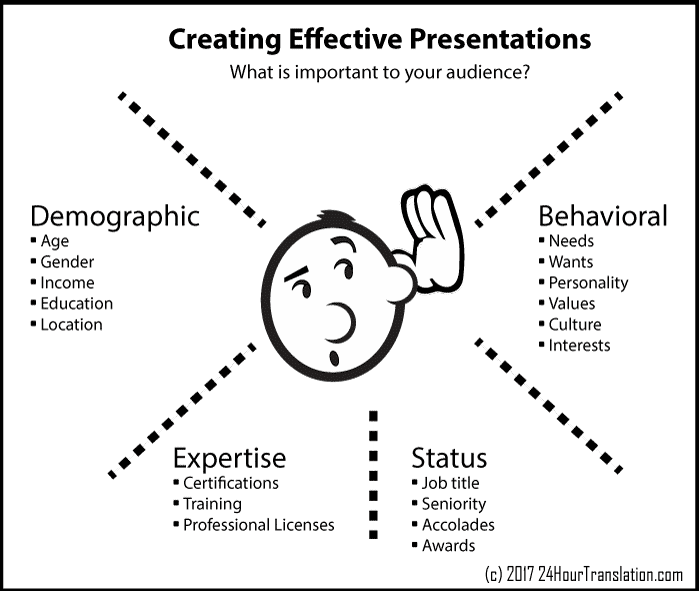To be an effective international communicator, you need to understand the needs of your target audience. Audience Analysis is a process for uncovering a deeper understanding about your audience and drives the process for creating appropriate and useful subject matter. Audience Analysis is also effective at directing the style, tone and mood that will be most effective for communicating to your audience.
When conducting an audience analysis, a writer should focus on the three most important aspects of audience members that include (1) demographics, (2) dispositions and (3) subject matter experience. Within these three areas of your audience analysis, there are a series of questions that should be answered and will inspire additional thoughts pertaining to your audience and your presentation.
In this article, we review the portion of the demographics analysis that reviews the different functions that an audience member might serve. It’s important to understand who holds these roles across cultures. For international presentation, a Kansas City translation services company like 24 Hour Translation can provide expert advice. Generally speaking, an audience in an organization might consist of the following:
1. Gatekeeper Audience
A gatekeeper is a person within an organization that can prevent your message from reaching the intended recipient. In some cases, a gatekeeper may exist outside of the organization, for example, an editor with a trade journal who controls what press releases will be printed. Whether internal or external, the gatekeeper decides who, if anyone, receives your message. Sometimes, a gatekeeper might be an executive assistant and in other organizations it might be someone higher in the organization.
2. Primary audience
The primary audience consists of those people who receive your presentation directly. It’s this audience that will choose whether to embrace or reject your conclusions and act. The primary audience is decision-making authority. Their buy-in is critical to the success of your presentation and recommendations.
3. Secondary audience
While the primary audience must buy into your message. Generally, your secondary audience consists of individuals who must implement your conclusions and recommendations once they have been accepted by the primary audience.
3. Auxiliary audience
The term auxiliary typically refers to a backup, secondary, supplement, or reserve. You may be familiar with the terms auxiliary police force, auxiliary engines, or auxiliary military troops. Often in large meetings there will be an auxiliary audience who may not have the responsibility or power to do anything with your message except listen and retain what you are communicating.
4. Watchdog audience
Generally, in a business or political setting the term watchdog refers to an individual or group that observes the conduct and actions of organizations that may contribute to the health and welfare of society. While a watchdog can’t prevent the communication of your message, the way they interpret your message and rebroadcast your message to larger and influential communities can either be an opportunity or a threat.
Within an audience, any recipient of your message can take on one or more of the roles listed above. Therefore, it’s wise to understand composition of your audience when completing an audience profile and then determine objectives and content that the audience will find necessary, useful, inspiring and actionable.


